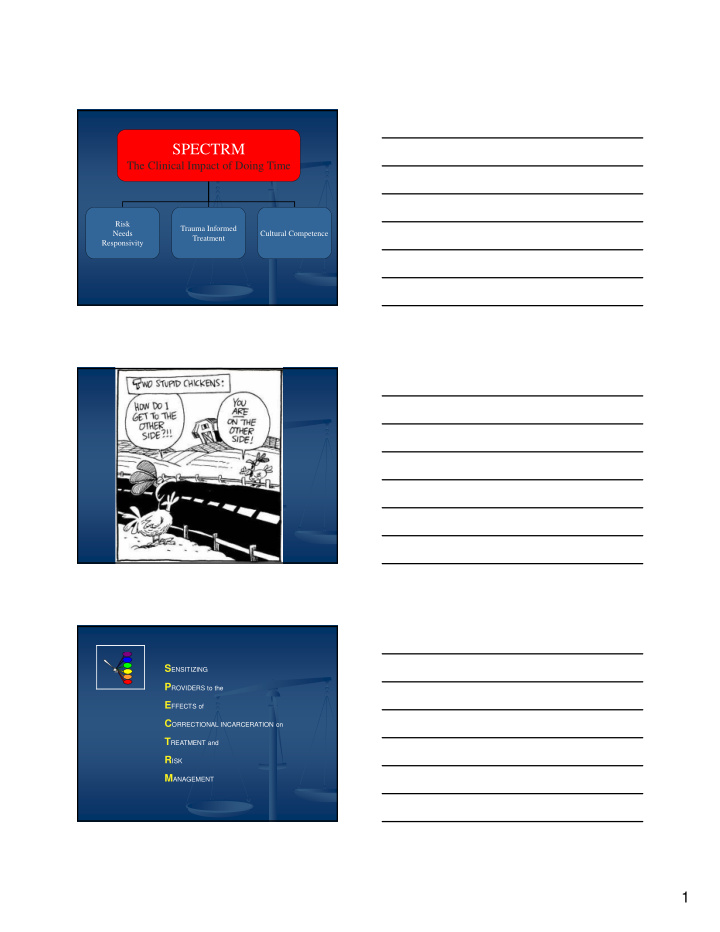



SPECTRM The Clinical Impact of Doing Time Risk Trauma Informed Needs Cultural Competence Treatment Responsivity S ENSITIZING P ROVIDERS to the E FFECTS of C ORRECTIONAL INCARCERATION on T REATMENT and R ISK M ANAGEMENT 1
About SPECTRM The Challenge: Clinical Impact of Doing Time The Approach: Cultural Competence The Technology: Cognitive Behavioral The Objective: Therapeutic Engagement The first night's the toughest, no doubt about it. They march you in naked as the day you were born, skin burning and half blind from that delousing shit they throw on you, and when they put you in that cell...and those bars slam home... that's when you know it's for real. A whole life blown away in the blink of an eye. Nothing left but all the time in the world to think about it. SPECTRM The Clinical Impact of Doing Time Risk Trauma Informed Needs Cultural Competence Treatment Responsivity 2
RNR R isk Match treatment intensity to level of risk N eeds Treat the offender, not the offense R esponsivity Modality must be one to which offender is responsive CBT Engagement Responsivity : Tailoring Treatment General Responsive to learning styles e.g. CBT Specific Responsive to socio-biological personality factors 3
Responsivity Principle Engagement Challenges Motivation Motivational Interviewing Stigma CJ culture Adaptation SPECTRM Why focus on engagement? Treatment outcome and premature termination predicted by engagement Treatment outcome related to patient effort Manner of therapist related to engagement and effort Responsivity Readiness of the program for the population Readiness of the person for the program 4
SPECTRM The Clinical Impact of Doing Time Risk Trauma Informed Needs Cultural Competence Treatment Responsivity Trauma Inmate trauma history prevalence 33% of men 55% of women Incarceration experience Verbal and physical victimization Witness violence Fear of violence Trauma Consequences Isolation Hypervigilance Emotional reactivity Intervention principles Safe environment Processing of Trauma Identification of coping strategies 5
SPECTRM The Clinical Impact of Doing Time Risk Trauma Informed Needs Cultural Competence Treatment Responsivity Cultural Competence Cultural Awareness Similarities and differences between groups Cultural Sensitivity Emotional expression Problems, struggles and joys Cultural Competence Beliefs, norms and values Knowledge and skills to incorporate Cultural Competence Cultural Proficiency Meaning of symptoms, illness, stressors Meaning of treatment Relationship with professionals Overcoming mistrust Communication Rapport Disclosure Using “ natural ” community support 6
Incarceration as Cultural Adaptation These walls are kind of funny. First you hate 'em, then you get used to 'em. Enough time passes, gets so you depend on them. That's institutionalized. “Those of us who do assessment research in correctional settings must continually remember that we are dealing with atypical, highly biased samples of people exposed to massive situational influences specifically designed to alter their attitudes, personality and behavior. Incarceration is a massive intervention that affects every aspect of a person’s life for extended periods of time.” Megargee, 1995 Cultural Sensitivity The Environment: Problems, Struggles (and Joys?) Psychological Environment Constant threat of danger – of violence Social Environment Racial/Ethnic associations Urban/Rural differences Gangs/Organizations DOC’s rules/Inmate Code Physical Environment Jail vs. Prison Gen Pop vs. MH Housing vs. SHU 7
Cultural Competence Values Attitudes Beliefs Language Behavior Meaning Cultural Competence Prison and jail populations typically value strength in all its manifestations - from physical strength to self reliance. Projecting an image of being tough and menacing as an example is highly adaptive in these environments. Meaning? Cultural Competence Prison and jail populations typically are characterized by presumptive distrust – distrust of staff – distrust of peers. Guardedness and secretiveness are adaptive attitudes within correctional environments. Meaning? 8
Cultural Competence “Snitches get stitches” is a prison and jail belief shared by everyone. While snitching goes on all the time in prison and jail – because information is a commodity that can be traded for gain – everyone is aware of the consequences of being caught – of being identified as a snitch. Meaning? Cultural Competence Prison and jail are environments of constant danger and threat of violence. They require a level of alertness which anywhere else would be characterized as hypervigilence . Meaning? Cultural Competence “Punk City” - “Push up on” - “Kite” - “Boomerang” - “Newjack”- “Hang up” – “Juice” - “Box” – “Bing” – “Hole” – “SHU” – “Shank” – “Gun” – “Bug” – “MO” – “Skittle” – “703” – “Jailin” Meaning? 9
Inmate Code Do Your Own Time Mind Your Own Business Trust No One Show Respect Ignore Others ’ Infractions Don ’ t Steal Don ’ t Snitch Don ’ t Show Weakness Don ’ t Stare Inmate Code MEANING VALUE Isolate Do Your Own Time Manipulate Trust No One Don ’ t share information Don ’ t Snitch Look aggressive Don ’ t Show Weakness Responsivity Readiness of the program for the population Readiness of the person for the program 10
Client Readiness: RAP I have trouble sleepin' at night. I have bad dreams like I'm falling. I wake up scared. Sometimes it takes me a while to remember where I am. RAP: Group Processes CONNECTING War stories EXPLORING Psycho-Education: Setting Differences and Similarities: Scripts CHANGING Cognitive Behavioral Technology: ABCD analysis 11
CONCLUSIONS Three Principles CONNECTING Be willing to listen and learn: Where were you and what was it like? EXPLORING Be aware of differences and similarities in the two cultures: What are the cues? CHANGING Be neutral: Is it working for you here? “ The insane criminal has nowhere any home: no age or nation has provided a place for him. He is everywhere unwelcome and objectionable. The prisons thrust him out; the hospitals are unwilling to receive him…And yet Howard Jarvis, humanity and justice, the sense of American Journal of common danger, and a tender regard Insanity, 1857 for a deeply degraded brother-man, all agree that something should be done for him—that some plan must be devised different from, and better than any that has yet been tried, by which he may be properly cared for, by which his malady may be healed, and his criminal propensity overcome. ” Free! 12
Free! 13
Recommend
More recommend